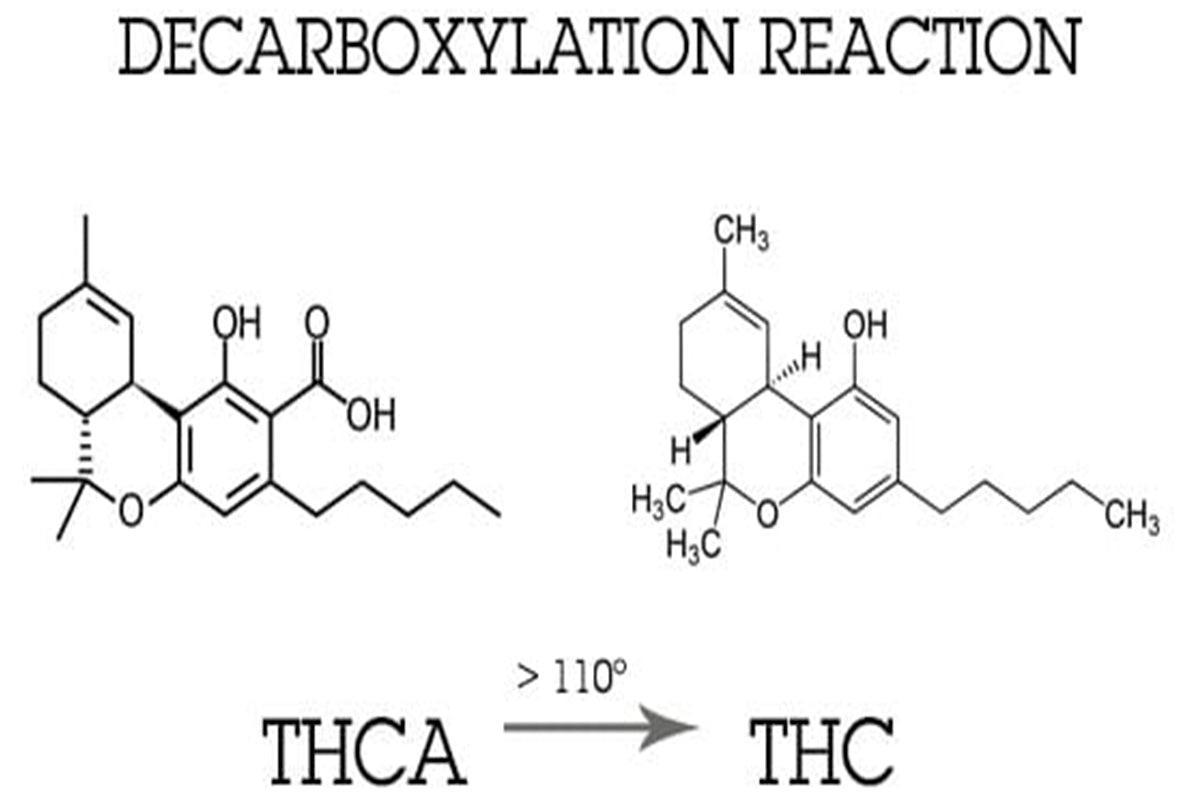In this article we will tell you about something fundamental but that very few know: the decarboxylation of cannabis. A simple chemical process, through an increase in temperature that "turns on" and stimulates the production of cannabinoids. A fundamental concept when talking about "eating cannabis" or for marijuana-based teas or infusions. Read the whole article to discover the secrets of decarboxylation, specifically we will tell you:
- Decarboxylate, why?
- The advantages of decarboxylation
- What does decarboxylation mean
- Decarboxylation: easier said than done
- Alternative methods
When we say that cannabis contains THC and CBD we make an imprecise statement. The truth is that various species of cannabis potentially contain THC and CBD .
In fact, to make these two cannabinoids active it is necessary to subject the inflorescences to a process called " decarboxylation " .
Perhaps those who have smoked or vaporized genuine marijuana will be ready to swear that they have fully enjoyed its effects even without being subjected to any preventive treatment.
But it will be enough for him to eat a small quantity of dried buds to have a counter-proof: "raw" does not make you high because the active ingredient remains inert . No psychoactive effect! Or no CBD effect! While when you smoke you activate (probably without knowing it) the carboxylation process.
The advantages of decarboxylation
Decarboxylation is a somewhat obscure term, but it actually indicates the effect of a very simple process: the violent deprivation of the humidity contained in the inflorescences.
This is why smoking marijuana makes you high and eating it raw does not: because by smoking it it is subjected to instant decarboxylation which makes the potentially contained THC immediately available.
At this point you might think that an article with instructions for subjecting marijuana to a chemical process that would be triggered by smoking it anyway makes little sense. And yet more and more people appreciate the benefits of THC and CBD but prefer not to smoke cannabis.
So, for example, CBD is available in a wide range of formats (from oil to capsules to crystals) obtained strictly from the decarboxylation of cultivated cannabis.
And this is why even in Italy there is an ever-increasing number of recipes for dishes that contain cannabis: from butter to coconut oil to cannabis right down to cocktails!
As already mentioned in a previous article of ours , only foods that contain buds can maintain the effects of the cannabinoids contained and transmit them to the guests. But for this to happen you must first "cook" the buds. For this reason, eating a dish that contains marijuana that has undergone prior decarboxylation makes you high, while eating raw buds is much less so . And therefore thinking that it is sufficient to put tops in the biscuit dough that will then go into the oven is pure illusion.
It will certainly have happened to more than one person to obtain brownies from excellent marijuana that induce a dramatically mild effect.
This is due to the fact that only the cannabis present on the edges or surface of the dough has been exposed to a temperature high enough to allow the THC contained to develop , while that inside the dough probably has not.
The same can be said for baked recipes that require relatively low temperatures, not to mention teas, herbal teas and infusions that are not properly prepared .
To summarize, cannabis consumption: whether you want to sell CBD or THC-based products, or whether you want to cook cannabis to enjoy its effects, it is necessary for the inflorescences to undergo the decarboxylation process . So let's see in more detail what it is about.
Looking for some cannabis? Have you ever tried our mini bulk of different weights and qualities? Never again without an escort.
 What does decarboxylation mean
What does decarboxylation mean
As we know, cannabis is seen as an extremely rich plant because, among other things, it contains a large quantity of cannabinoids , the best known of which are THC and CBD.
However, these two are originally contained in their acid form : THCA and CBDA respectively.
For these to cross the blood-brain barrier of our brain and have the well-known effects, they must be subjected to high temperatures which trigger chemical reactions.
And which allow it to be converted into THC and CBD.
These are chemical reactions that also occur spontaneously, through the natural drying of the buds exposed to the air. But the slowness of this dehydration does not allow appreciable effects.
The same chemical reaction must occur much more quickly, and the simplest and most widespread method is "cooking" cannabis in the oven.
A sufficiently high temperature triggers the rapid removal of a carboxyl group from the inflorescences, which "evaporates" from the plant in the form of water and carbon dioxide. Carbon dioxide is a compound that is absorbed by cannabis like any other plant during its vegetal cycle through the well-known chlorophyll photosynthesis , and which will bind to hydrogen to form carboxylic acid.
This dynamic is called "carboxylation" and as it is easy to understand, decarboxylation is its exact opposite. With decarboxylation the mild effects of THCA and CBDA are enhanced by the more energetic THC and CBD .
And now let's look more specifically at how to decarboxylate cannabis at home: a simple, safe and relatively quick method. And not just for those who want to try cannabis in the kitchen: decarbing is also a recommended practice for those who want to smoke or vaporize it because it still increases the potency of the THC, CBD and other cannabinoids contained.
Decarboxylation: easier done than said
The premise is that it is good to start with excellent grass . This does not just mean the quality of the grass (although it is true that decarboxylation does not make poor grass good) but also the care with which the preventive drying process in the open air was carried out.
With the same quality of the starting plant, a well-groomed and preserved harvest ensures a higher yield of THCA and CBDA and therefore a better basis for decarbing .
The buds must not have mold, and drying must be uniform and not excessive.
The quantity of cannabis is up to your discretion, although it is essential that it allows the inflorescences to be evenly distributed in the oven, without overlapping.
For effective decarbing you will need a dripping pan (or baking tray), some tin foil and ordinary baking paper. And a grinder .
The grinder , for the few who don't know, is a round grinder, rudimentary but effective, made up of two interlocking halves equipped inside with small teeth arranged so as not to collide during the rotation of the two halves, a rotation which allows grinding .
The grinder is designed for chopping vegetables, but we don't know anyone who has ground anything other than hemp with it. The first thing to do is in fact to finely chop our buds .
Meanwhile, preheat the oven to 110 degrees Celsius . This last fact is not indisputable: some prefer to decarboxylate at 120 degrees, others on the contrary at 90.
Obviously a lower temperature will lead to longer "cooking" times and vice versa: around 75 minutes for 90 degrees, 50 - 60 minutes for 110 degrees and just 30 minutes with the oven at 120 degrees.
But it is good to put aside the temptation to hurry: by letting our buds cook at lower temperatures, in addition to not running the risk of burning the weed, we will have better preservation of the aromas and terpenes of cannabis.
The latter, although rarely mentioned, are essential components of cannabis plants and their contribution is appreciated and sought after.
It is at least worth mentioning here that terpenes are a group of unsaturated volatile hydrocarbons found in the essential oils of many plant species, and hemp is no exception.
Although non-psychoactive, they are linked to CBD and are responsible for many of the most beneficial effects of the plant: they have anti-inflammatory, antiseptic, expectorant, analgesic, antifungal properties and we stop here. Although the list would be long.
So, let's repeat: the oven temperature options are varied, but we recommend calm and patience. In any case: it is good to remember to set a timer, as timing plays an essential role (not to mention... fatal!)
After shredding the tops you need to take the baking tray and line it with baking paper . Then lay the buds on top, taking care to spread them well and not to pile them up, so that all the hemp is exposed to the action of the oven.
Then you need to cover the pan with aluminum, as if to make a lid. This last operation must be carried out with care not only because it is important to retain the aroma offered by the terpenes , but above all so as not to immediately disperse the vapor released by the heat.
In fact, steam plays a fundamental role in correct drying , which must be rapid but not abrupt.
And now: bake. When the timer rings it is likely that the kitchen will be invaded by an unmistakable bittersweet aroma .
You need to take the pan out and let it cool. Finally you can remove the foil.
If everything went as it should, the buds will have a slightly "toasted" appearance, but absolutely not burnt.
For small quantities you can replace the pan with a Pyrex pan, always carefully closed with foil. In which case baking paper becomes superfluous.
Have you ever tried cannabis edibles? Look at our CBD and white chocolate dragees . A delicacy for the palate
Alternative methods
There are also other ways of decarboxylation , although less common.
One of these, although perhaps less practical than oven cooking, involves cooking in a bain-marie ! The chopped inflorescences must be placed inside a well-sealed bag suitable for cooking .
Then the bag is boiled in water for about ninety minutes, making sure that the quantity of water is always sufficient to completely cover the bag.
Finally you need to remove the bag and let it cool completely.
And voilà!
If the article was of interest to you, share it on social media with the rest of the Community, every single share helps us support our blog and keep you 360° informed on the world of Cannabis.
You might also be interested in:





 What does decarboxylation mean
What does decarboxylation mean






1 comment
Thanks for this great article from Germany. 😀👍